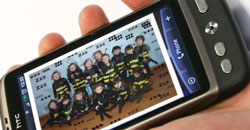'2D is the opportunity to use data to communicate with the consumer on their smart phone. It is part of what was a big trend, but now is viewed as part of our lives, mobility. Mobile marketing is driving 2D and is a pillar of 2D.'
This is according to Enzo Capobianco (left), EMEA Market Development Manager at Honeywell, who was a speaker at the recent World Retail Congress, held in Johannesburg. I caught up with him and asked him about some of the key trends we will be seeing in retail soon.
Mobile marketing
A key trend we will see going forward is the use of mobile marketing by retailers says Capobianco, who quotes Starbucks as a good case study of how retailers can utilise the mobile. "The consumer creates a Starbucks account online and puts money into the account. Starbucks sends a QR Code to the consumer's mobile which he/she can then use in Starbucks as a mobile wallet and a loyalty card."
Personalisation
Coupons and loyalty cards are not personalised or relevant. For supermarkets utilising mobile marketing will mean they have to know their customers, and therefore this marketing is personalised. If a store knows you come in every day for bread, they can send you a coupon for bread. They will have to track your behaviour.
Sustainability
The next big trend is sustainability and mobile marketing fits in here perfectly, he says.
Coupons and loyalty cards are quite expensive for the retailer to print. The QR Code is a much more cost-effective option. "QR Codes are also more convenient for the consumer. Overseas a consumer can have as many as 50 loyalty cards in his/her wallet. Now you can "carry" a 2D code in your smart phone," says Capobianco. He remarks that the smart phone is the one thing that the consumer never leaves behind when leaving their home.
Trustability
But 2D goes beyond loyalty cards and couponing to the next trend, which is trustability. Any and every product on a shelf can have code, for example an apple or banana, and by scanning the code it will tell you exactly where that product comes from and how it was grown etc. So you could trace coffee beans from Kenya, and wine from South Africa.
Bridging the gap

Mobile is the store of the future says Enzo Capobianco. (Image: Wikimedia Commons)
The retailer will interact with the consumer using the smart phone. The second trend related to 2D involves the consumer. The trend involves the consumer researching products online and then going into the store to purchase the product. The problem is that the consumer too often knows more than the store's retail assistants do. When that happens, the reaction of the consumer is to leave the store. There exists a gap between store and online and stores have to use technology and empower the retail assistant. This technology can enable the retail assistant to provide information to shoppers. It will also evolve - and the technology is already there - to where that retail assistant can assist the shopper and then use the same device as a pay point. It will be a mobile point of sale.
"The store is still the main place we go to buy. We research what we want online abut go to the store because we want the in-store experience. But mobile is the store of the future. We will do mobile shopping in-store, by scanning the product and putting it in cart, then pushing the button and getting a QR Code, which is scanned and pays the store. This is in development now."
Why is 2D scanning technology important in the retail?
• It transforms the Point-of-Sale to a Point-of-Service. Solutions are available that improve customer service by minimising checkout time and providing different payment options, including mobile POS. Additionally, solutions can be implemented that allow the adoption of 2D bar codes and new mobile marketing applications that provide a more personalised customer offers, such as mobile couponing, e-gift cards, and mobile loyalty cards.
• Access to real-time, demands-based inventory. Integrated in real time with checkout product and customer data, these solutions allow retailers to improve the efficiency of their supply chain, maximise their customers' basket sizes, reduce stock-outs and increase their margin, ensuring they have the right products at the right price advertised with the right promotion at the right store.
• Empowering store employees. Thanks to the availability of merchandising and inventory applications on mobile terminals, store associates are now equipped with the productivity tools and technologies needed to interact and engage with shoppers and offer a guided selling service including information such as pricing, product availability and tailored promotions.














































